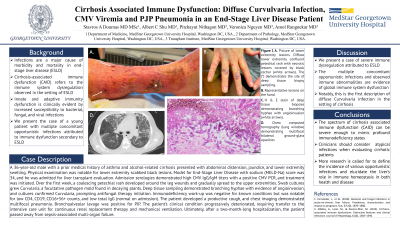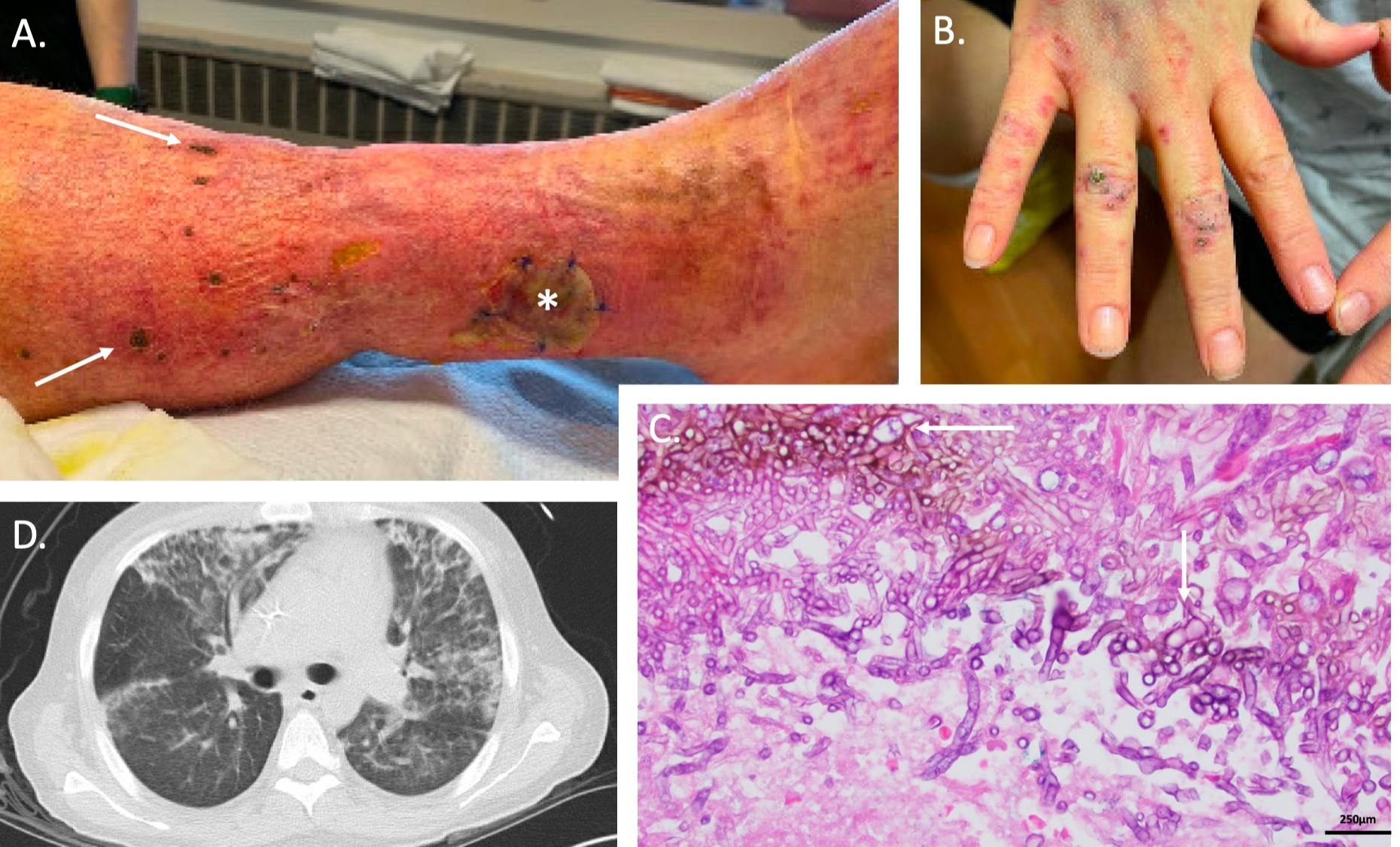Back


Poster Session B - Monday Morning
Category: Liver
B0574 - Cirrhosis-Associated Immune Dysfunction: Diffuse Curvulvaria Infection, CMV Viremia and PJP Pneumonia in an End-Stage Liver Disease Patient
Monday, October 24, 2022
10:00 AM – 12:00 PM ET
Location: Crown Ballroom

Has Audio

Stavros A. Doumas, MD, MSc
Medstar Georgetown University Hospital
Washington DC, DC
Presenting Author(s)
Stavros A. Doumas, MD, MSc1, Albert C. Shu, MD1, Pitchayut Nithagon, MD1, Veronica Nguyen, MD1, Amol S. Rangnekar, MD2
1Medstar Georgetown University Hospital, Washington, DC; 2MedStar Georgetown University Hospital, Washington, DC
Introduction: Infections are a major cause of morbidity and mortality in end-stage liver disease (ESLD). Cirrhosis-associated immune dysfunction (CAID) refers to the immune system dysregulation observed in ESLD. Innate and adaptive immunity dysfunction is clinically evident by increased susceptibility to bacterial, fungal, and viral infections. We present the case of a young patient with multiple concomitant opportunistic infections attributed to immune dysfunction secondary to ESLD.
Case Description/Methods: A 36-year-old male with a prior medical history of asthma and alcohol-related cirrhosis presented with abdominal distension, jaundice, and lower extremity swelling. Physical examination was notable for lower extremity scabbed black lesions. Model for End-Stage Liver Disease with sodium (MELD-Na) score was 34, and he was admitted for liver transplant evaluation. Admission serologies demonstrated high CMV IgG/IgM titers with a positive CMV PCR, and treatment was initiated. Over the first week, a coalescing petechial rash developed around the leg wounds and gradually spread to the upper extremities. Swab cultures grew Curvularia, a facultative pathogen mold found in decaying plants. Deep tissue sampling demonstrated branching hyphae with evidence of angioinvasion, and cultures confirmed Curvularia, prompting antifungal therapy initiation. Immunodeficiency work-up was negative for known conditions but was notable for low CD4, CD19, CD16+56+ counts, and low total IgG (normal on admission). The patient developed a productive cough, and chest imaging demonstrated multifocal pneumonia. Bronchoalveolar lavage was positive for PJP. The patient’s clinical condition progressively deteriorated, requiring transfer to the intensive care unit for continuous renal replacement therapy and mechanical ventilation. Ultimately, after a two-month-long hospitalization, the patient passed away from sepsis-associated multi-organ failure.
Discussion: Herein, we present a case of severe immune dysregulation attributed to ESLD. The multiple concomitant opportunistic infections and observed immune abnormalities support global immune dysfunction. Notably, this is the first description of diffuse curvulvaria infection in the setting of cirrhosis. This case demonstrates the spectrum of CAID, which can be severe enough to mimic profound immunodeficiency states. More research is called for to define the incidence of various opportunistic infections and elucidate the liver’s role in maintaining immune homeostasis in health and disease.

Disclosures:
Stavros A. Doumas, MD, MSc1, Albert C. Shu, MD1, Pitchayut Nithagon, MD1, Veronica Nguyen, MD1, Amol S. Rangnekar, MD2. B0574 - Cirrhosis-Associated Immune Dysfunction: Diffuse Curvulvaria Infection, CMV Viremia and PJP Pneumonia in an End-Stage Liver Disease Patient, ACG 2022 Annual Scientific Meeting Abstracts. Charlotte, NC: American College of Gastroenterology.
1Medstar Georgetown University Hospital, Washington, DC; 2MedStar Georgetown University Hospital, Washington, DC
Introduction: Infections are a major cause of morbidity and mortality in end-stage liver disease (ESLD). Cirrhosis-associated immune dysfunction (CAID) refers to the immune system dysregulation observed in ESLD. Innate and adaptive immunity dysfunction is clinically evident by increased susceptibility to bacterial, fungal, and viral infections. We present the case of a young patient with multiple concomitant opportunistic infections attributed to immune dysfunction secondary to ESLD.
Case Description/Methods: A 36-year-old male with a prior medical history of asthma and alcohol-related cirrhosis presented with abdominal distension, jaundice, and lower extremity swelling. Physical examination was notable for lower extremity scabbed black lesions. Model for End-Stage Liver Disease with sodium (MELD-Na) score was 34, and he was admitted for liver transplant evaluation. Admission serologies demonstrated high CMV IgG/IgM titers with a positive CMV PCR, and treatment was initiated. Over the first week, a coalescing petechial rash developed around the leg wounds and gradually spread to the upper extremities. Swab cultures grew Curvularia, a facultative pathogen mold found in decaying plants. Deep tissue sampling demonstrated branching hyphae with evidence of angioinvasion, and cultures confirmed Curvularia, prompting antifungal therapy initiation. Immunodeficiency work-up was negative for known conditions but was notable for low CD4, CD19, CD16+56+ counts, and low total IgG (normal on admission). The patient developed a productive cough, and chest imaging demonstrated multifocal pneumonia. Bronchoalveolar lavage was positive for PJP. The patient’s clinical condition progressively deteriorated, requiring transfer to the intensive care unit for continuous renal replacement therapy and mechanical ventilation. Ultimately, after a two-month-long hospitalization, the patient passed away from sepsis-associated multi-organ failure.
Discussion: Herein, we present a case of severe immune dysregulation attributed to ESLD. The multiple concomitant opportunistic infections and observed immune abnormalities support global immune dysfunction. Notably, this is the first description of diffuse curvulvaria infection in the setting of cirrhosis. This case demonstrates the spectrum of CAID, which can be severe enough to mimic profound immunodeficiency states. More research is called for to define the incidence of various opportunistic infections and elucidate the liver’s role in maintaining immune homeostasis in health and disease.

Figure:
A. Picture of lower extremity lesions. Diffuse lower extremity confluent petechial rash with necrotic lesions covered by black eschar (white arrows). The (*) demonstrates the site of deep tissue biopsy sampling.
B. Representative lesions on the hand.
C. H & E stain of deep tissue biopsies demonstrating branching hyphae with angioinvasion (white arrows).
D. Chest computed tomography (lung window) demonstrating multifocal bilateral ground-glass opacities.
A. Picture of lower extremity lesions. Diffuse lower extremity confluent petechial rash with necrotic lesions covered by black eschar (white arrows). The (*) demonstrates the site of deep tissue biopsy sampling.
B. Representative lesions on the hand.
C. H & E stain of deep tissue biopsies demonstrating branching hyphae with angioinvasion (white arrows).
D. Chest computed tomography (lung window) demonstrating multifocal bilateral ground-glass opacities.
Disclosures:
Stavros Doumas indicated no relevant financial relationships.
Albert Shu indicated no relevant financial relationships.
Pitchayut Nithagon indicated no relevant financial relationships.
Veronica Nguyen indicated no relevant financial relationships.
Amol Rangnekar indicated no relevant financial relationships.
Stavros A. Doumas, MD, MSc1, Albert C. Shu, MD1, Pitchayut Nithagon, MD1, Veronica Nguyen, MD1, Amol S. Rangnekar, MD2. B0574 - Cirrhosis-Associated Immune Dysfunction: Diffuse Curvulvaria Infection, CMV Viremia and PJP Pneumonia in an End-Stage Liver Disease Patient, ACG 2022 Annual Scientific Meeting Abstracts. Charlotte, NC: American College of Gastroenterology.
